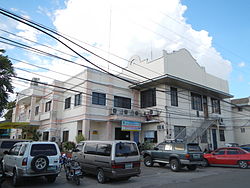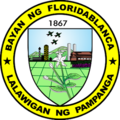Top Qs
Timeline
Chat
Perspective
Floridablanca, Pampanga
Municipality in Pampanga, Philippines From Wikipedia, the free encyclopedia
Remove ads
Floridablanca, officially the Municipality of Floridablanca (Kapampangan: Balen ning Floridablanca; Filipino: Bayan ng Floridablanca) is a municipality in the province of Pampanga, Philippines. According to the 2020 census, it has a population of 135,542 people.[3]
This article needs additional citations for verification. (August 2011) |
Remove ads
Etymology
Summarize
Perspective
Previously, the town was named San Jose de Calampaui, which is derived from Spanish for Saint Joseph, its patron saint. Floridablanca itself is derived from Spanish which translates to "white flower." However, there are two versions of the name's origin.[5]
One version suggest that the town was named in honor of José María de Castillejo y Moñino, III conde of Floridablanca, (25 de Febrero de 1826 y falleció en 1892), who inherited the Condado de Floridablanca from the 2nd holder, his aunt Maria Vicenta Moñino y Pontejos, through his mother, Maria Ana. Maria Vicenta died in 1867 and thus Jose inherited the title; 1867 was also the year the town's name was changed from San Jose de Calampaui to Floridablanca. The rest of Maria Vicenta's titles devolved to her husband's family, the Marquesado de Miraflores whose present title holder today married the granddaughter of President Elpidio Quirino.
Jose Maria conquered the island of Menorca and helped create the Viceroyalty of La Plata or all the lands in present day Argentina and nearby. As a renowned statesman of the time, he helped Spain counterbalance its position between warring France and England. He also established the Compania de Filipinas in the South Seas that kept the Philippines connected to Spain through the maritime routes regularly passing to the upper stretches of Nuevo Mexico (a part of the Viceroyalty of Nueva Espana) down to the ports of Callao in Peru, where the Manila Galleon ships were known as the La Nao de Manila or the La Nao de China.
1867 was also the year when the de tallado image of San Jose Obrero and the de tallado Santo Nino accompanying it, was installed in the church of Saint Joseph the Worker church to signify the establishment of the new parroquia for the farm workers, separate from the old Spanish monastery of San Jose de Calampaui, and separate from the friars who owned all the lands from the foot of the mountains to the eastern boundaries of the nearly flat expanse that is Floridablanca.
Another version of a more credible origin suggests that the town was named after the white flowers of a pandacaqui plant (Tabernaemontana pandacaqui) that flourished in the area. Florida means "flower" and blanca means "fragrant".
Remove ads
History

Floridablanca was founded in 1823 as Hacienda de San Jose de Caumpaui at the site of a monastery. In 1867, it was renamed to Pueblo de Floridablanca.
In the 1920s, the Pampanga Sugar Mill was built at Del Carmen in the 1920s. The area was the site of military bases of the Philippine Commonwealth Army and the Philippine Constabulary from 1942 to 1946. The Philippine Air Force established Basa Air Base at a former American military airfield in 1947.[5]
In 1991, the Santo Nino enshrined in San Jose Obrero parish was stolen. Within two months or so, Mount Pinatubo erupted. Sand and ash and lahar fell into Floridablanca, killing hundreds and destroyed the rice paddies. Superstitions by the elders of the town exist that the theft of the statue resulted in such unimaginable disaster.
In 2024, the Santo Nino was rediscovered after almost 22 years. The Foronda family assisted in raising funds for its eventual return to San Jose Obrero parish.
Remove ads
Geography
Summarize
Perspective
Floridablanca is located on the western part of Pampanga along the Zambales Mountains and is bounded by the municipalities of Porac on the north, Lubao on the south, Guagua on the east, and Dinalupihan on the west. It is 40 kilometres (25 mi) from the city of San Fernando, 106 kilometres (66 mi) from Manila, 41 kilometres (25 mi) from Balanga, and 15 kilometres (9.3 mi) from Porac.
The town is at an elevation of 12 feet (3.7 m) above sea level. Floridablanca is north of Dinalupihan via Dinalupihan-Floridablanca Access Road at the Bataan-Pampanga boundary line.
With an area of 17,548 hectares (43,360 acres), it is the third largest municipality in the province, after Porac and Candaba.
Barangays
Floridablanca is politically subdivided into 33 barangays, as shown below. Each barangay consists of puroks and some have sitios.
- Anon
- Apalit
- Basa Air Base
- Benedicto
- Bodega
- Cabangcalan
- Calantas
- Carmencita
- Consuelo
- Culubasa
- Dampe
- Del Carmen
- Fortuna
- Gutad
- Mabical
- Maligaya
- Mawacat
- Nabuclod
- Pabanlag
- Paguiruan
- Palmayo
- Pandaguirig
- Poblacion
- San Antonio
- San Isidro
- San Jose
- San Nicolas
- San Pedro
- San Ramon
- San Roque
- Santa Monica
- Solib
- Santo Rosario
- Valdez
Climate
Demographics
In the 2020 census, the population of Floridablanca, Pampanga, was 135,542 people,[3] with a density of 770 inhabitants per square kilometer or 2,000 inhabitants per square mile.
Remove ads
Economy
Poverty incidence of Floridablanca
5
10
15
20
25
30
2000
21.31 2003
18.30 2006
8.10 2009
13.42 2012
6.78 2015
13.13 2018
2.92 2021
9.39 Source: Philippine Statistics Authority[11][12][13][14][15][16][17][18] |
Floridablanca is the second largest producer of rice in the province. It produces more than enough rice to meet its needs resulting in a surplus. In 1999, only 37.76% of its produce was used for its own rice requirement resulting in a surplus of 65.24% equivalent to 17,553 metric tons.
Banking and finance
The Bank of Florida, formerly Rural Bank of Floridablanca, Inc. was first established on February 10, 1964, with its first branch in Floridablanca, as one of the six subsidiaries of House of David Group headed by Ladislao Sibal-David, founder and chair.[19] Its executive office, the BOF Corporate Center is located along Jose Abad Santos Avenue, San Jose, City of San Fernando, Pampanga.[20]
Remove ads
Government
Local government
Like other towns in the Philippines, Floridablanca is governed by a mayor and vice mayor who are elected to three-year terms. The mayor is the executive head and leads the town's departments in executing the ordinances and improving public services. The vice mayor heads a legislative council (Sangguniang Bayan) consisting of councilors from the Barangays of Barrios.
List of Municipal Leaders
Capitan Municipal
- 1897 – Don Gerónimo Romero Dinio
- 1898 – Don Cecilio Alvendia
- 1899 – Don Alejandro Ramos
Municipal Presidents
- 1900–1902 – Don Gerónimo Romero Dinio
- 1903–1905 – Don Alejandro Ramos
- 1906–1908 – Don Gregorio Panlaqui
- 1909–1911 – Don León Gutiérrez
- 1911 – Don Arcadio Ramírez
- 1912–1917 – Don Martin Sundiam
- 1918–1922 – Don José O. Dinio
- 1923–1925 – Don Isidoro Alvendia
- 1926–1931 – Don Roberto Nuguid
- 1932–1937 – Don Camilo Ocampo
Remove ads
Tourism
Aside from Basa Air Base, the town has cultural treasures and interesting points.
- 1887 San Jose Obrero Parish Church: the Roman Catholic Archdiocese of San Fernando exercises jurisdiction over the Heritage Church.
- Bahay na Puti (Alvendia House): the Justice Carmelino Alvendia, Sr. ancestral mansion is owned, preserved and maintained by his family.
- Bale Kastila (Paguiruan): a heritage mansion from 1800's.
Remove ads
Wikiwand - on
Seamless Wikipedia browsing. On steroids.
Remove ads






